Business Administration Report: Decision Making and Leadership
VerifiedAdded on 2020/12/09
|13
|4141
|245
Report
AI Summary
This report analyzes key aspects of business administration, focusing on leadership, decision-making, and management theories within the context of Tesco plc. It explores the importance of defining objectives, scope, and success, along with the potential impact of decision-making and the validation of information. The report differentiates between managers and leaders, evaluating the suitability and impact of different leadership styles and examining various motivation theories. It also covers the responsibilities of managers in planning, coordinating, and controlling work, ensuring team objectives are met, and aligning decisions with business objectives. Furthermore, the report delves into operational constraints imposed by budgets and the relationship between business objectives and performance measures, including how to set key performance indicators and monitor business performance. The report provides a comprehensive overview of leadership and management principles relevant to business administration.
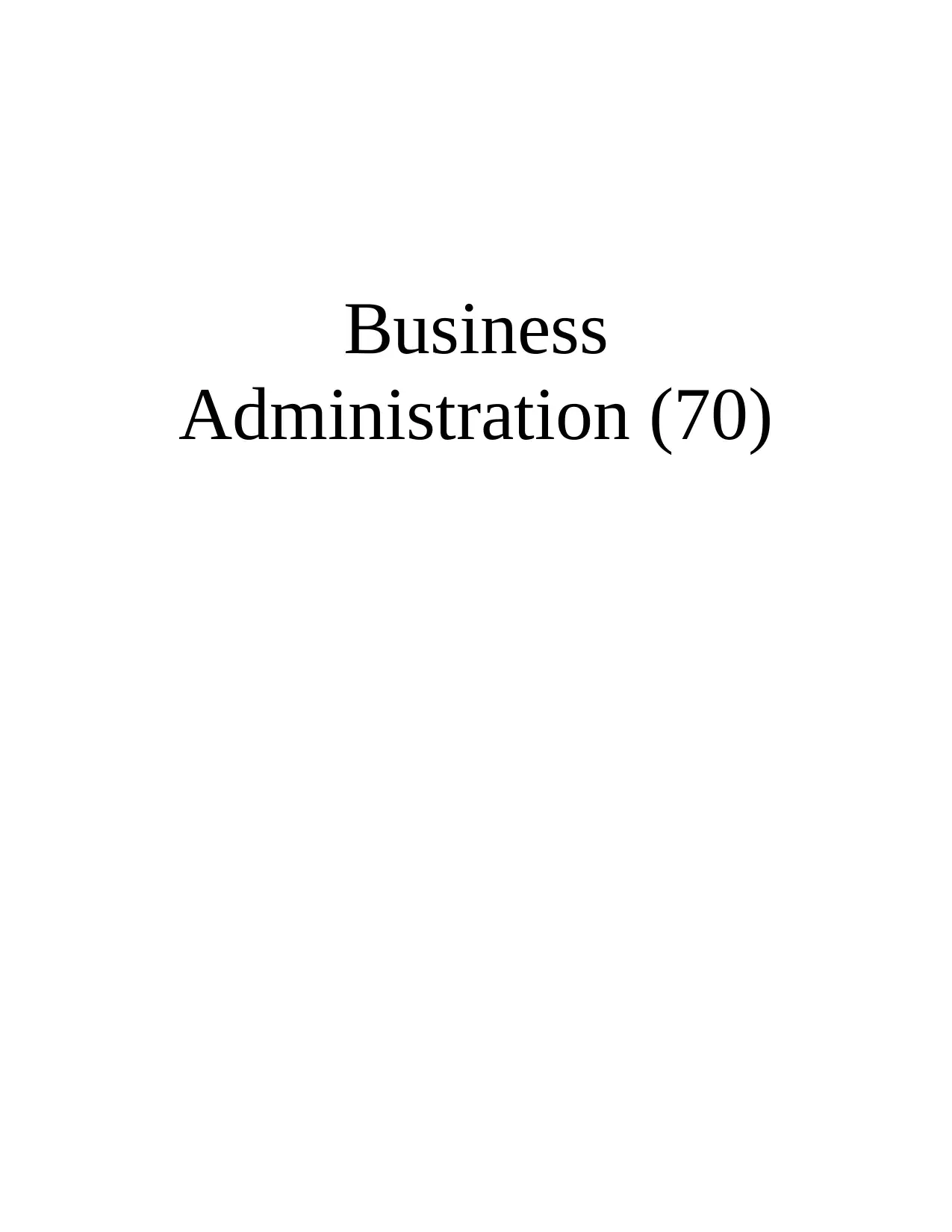
Business
Administration (70)
Administration (70)
Secure Best Marks with AI Grader
Need help grading? Try our AI Grader for instant feedback on your assignments.
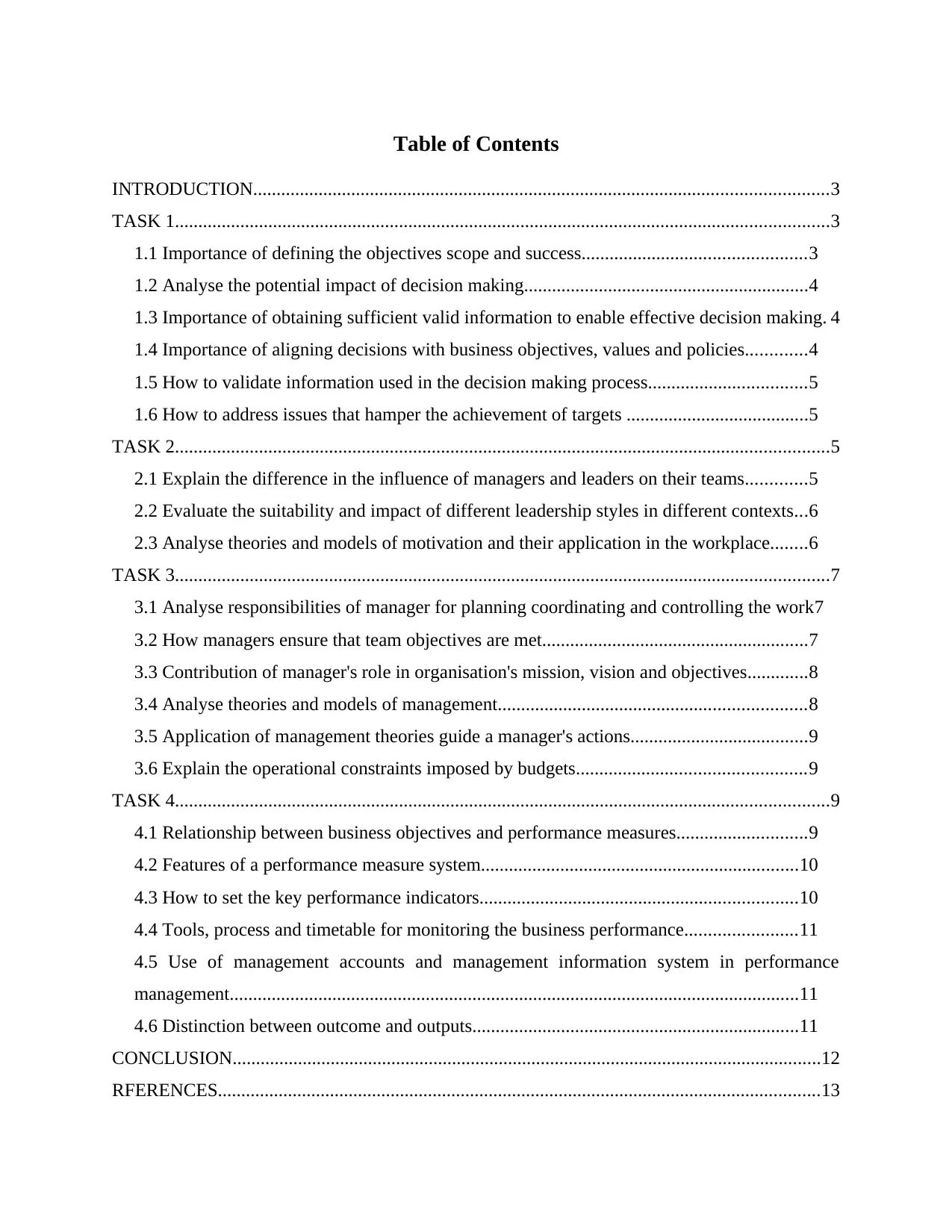
Table of Contents
INTRODUCTION...........................................................................................................................3
TASK 1............................................................................................................................................3
1.1 Importance of defining the objectives scope and success................................................3
1.2 Analyse the potential impact of decision making.............................................................4
1.3 Importance of obtaining sufficient valid information to enable effective decision making. 4
1.4 Importance of aligning decisions with business objectives, values and policies.............4
1.5 How to validate information used in the decision making process..................................5
1.6 How to address issues that hamper the achievement of targets .......................................5
TASK 2............................................................................................................................................5
2.1 Explain the difference in the influence of managers and leaders on their teams.............5
2.2 Evaluate the suitability and impact of different leadership styles in different contexts...6
2.3 Analyse theories and models of motivation and their application in the workplace........6
TASK 3............................................................................................................................................7
3.1 Analyse responsibilities of manager for planning coordinating and controlling the work7
3.2 How managers ensure that team objectives are met.........................................................7
3.3 Contribution of manager's role in organisation's mission, vision and objectives.............8
3.4 Analyse theories and models of management..................................................................8
3.5 Application of management theories guide a manager's actions......................................9
3.6 Explain the operational constraints imposed by budgets.................................................9
TASK 4............................................................................................................................................9
4.1 Relationship between business objectives and performance measures............................9
4.2 Features of a performance measure system....................................................................10
4.3 How to set the key performance indicators....................................................................10
4.4 Tools, process and timetable for monitoring the business performance........................11
4.5 Use of management accounts and management information system in performance
management..........................................................................................................................11
4.6 Distinction between outcome and outputs......................................................................11
CONCLUSION..............................................................................................................................12
RFERENCES.................................................................................................................................13
INTRODUCTION...........................................................................................................................3
TASK 1............................................................................................................................................3
1.1 Importance of defining the objectives scope and success................................................3
1.2 Analyse the potential impact of decision making.............................................................4
1.3 Importance of obtaining sufficient valid information to enable effective decision making. 4
1.4 Importance of aligning decisions with business objectives, values and policies.............4
1.5 How to validate information used in the decision making process..................................5
1.6 How to address issues that hamper the achievement of targets .......................................5
TASK 2............................................................................................................................................5
2.1 Explain the difference in the influence of managers and leaders on their teams.............5
2.2 Evaluate the suitability and impact of different leadership styles in different contexts...6
2.3 Analyse theories and models of motivation and their application in the workplace........6
TASK 3............................................................................................................................................7
3.1 Analyse responsibilities of manager for planning coordinating and controlling the work7
3.2 How managers ensure that team objectives are met.........................................................7
3.3 Contribution of manager's role in organisation's mission, vision and objectives.............8
3.4 Analyse theories and models of management..................................................................8
3.5 Application of management theories guide a manager's actions......................................9
3.6 Explain the operational constraints imposed by budgets.................................................9
TASK 4............................................................................................................................................9
4.1 Relationship between business objectives and performance measures............................9
4.2 Features of a performance measure system....................................................................10
4.3 How to set the key performance indicators....................................................................10
4.4 Tools, process and timetable for monitoring the business performance........................11
4.5 Use of management accounts and management information system in performance
management..........................................................................................................................11
4.6 Distinction between outcome and outputs......................................................................11
CONCLUSION..............................................................................................................................12
RFERENCES.................................................................................................................................13
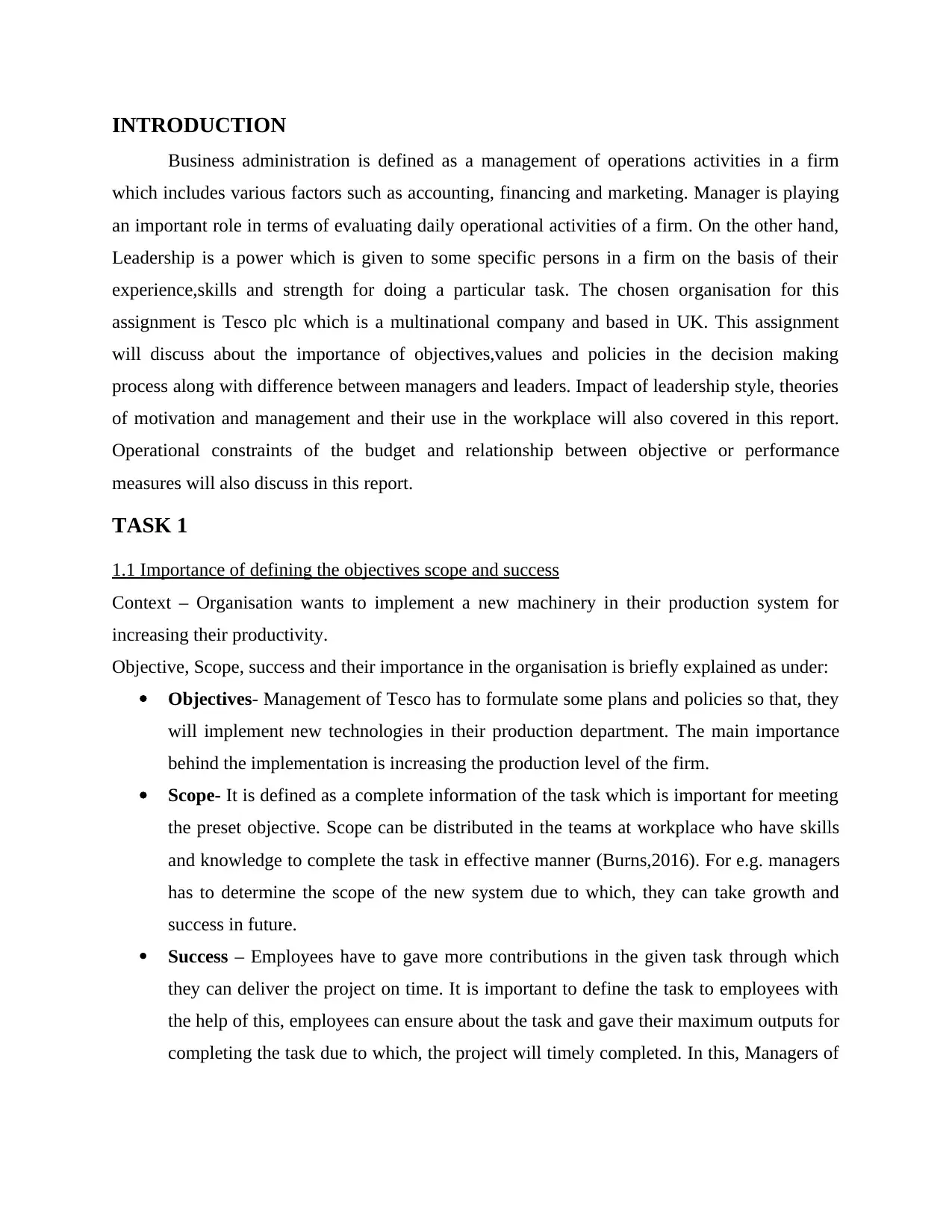
INTRODUCTION
Business administration is defined as a management of operations activities in a firm
which includes various factors such as accounting, financing and marketing. Manager is playing
an important role in terms of evaluating daily operational activities of a firm. On the other hand,
Leadership is a power which is given to some specific persons in a firm on the basis of their
experience,skills and strength for doing a particular task. The chosen organisation for this
assignment is Tesco plc which is a multinational company and based in UK. This assignment
will discuss about the importance of objectives,values and policies in the decision making
process along with difference between managers and leaders. Impact of leadership style, theories
of motivation and management and their use in the workplace will also covered in this report.
Operational constraints of the budget and relationship between objective or performance
measures will also discuss in this report.
TASK 1
1.1 Importance of defining the objectives scope and success
Context – Organisation wants to implement a new machinery in their production system for
increasing their productivity.
Objective, Scope, success and their importance in the organisation is briefly explained as under:
Objectives- Management of Tesco has to formulate some plans and policies so that, they
will implement new technologies in their production department. The main importance
behind the implementation is increasing the production level of the firm.
Scope- It is defined as a complete information of the task which is important for meeting
the preset objective. Scope can be distributed in the teams at workplace who have skills
and knowledge to complete the task in effective manner (Burns,2016). For e.g. managers
has to determine the scope of the new system due to which, they can take growth and
success in future.
Success – Employees have to gave more contributions in the given task through which
they can deliver the project on time. It is important to define the task to employees with
the help of this, employees can ensure about the task and gave their maximum outputs for
completing the task due to which, the project will timely completed. In this, Managers of
Business administration is defined as a management of operations activities in a firm
which includes various factors such as accounting, financing and marketing. Manager is playing
an important role in terms of evaluating daily operational activities of a firm. On the other hand,
Leadership is a power which is given to some specific persons in a firm on the basis of their
experience,skills and strength for doing a particular task. The chosen organisation for this
assignment is Tesco plc which is a multinational company and based in UK. This assignment
will discuss about the importance of objectives,values and policies in the decision making
process along with difference between managers and leaders. Impact of leadership style, theories
of motivation and management and their use in the workplace will also covered in this report.
Operational constraints of the budget and relationship between objective or performance
measures will also discuss in this report.
TASK 1
1.1 Importance of defining the objectives scope and success
Context – Organisation wants to implement a new machinery in their production system for
increasing their productivity.
Objective, Scope, success and their importance in the organisation is briefly explained as under:
Objectives- Management of Tesco has to formulate some plans and policies so that, they
will implement new technologies in their production department. The main importance
behind the implementation is increasing the production level of the firm.
Scope- It is defined as a complete information of the task which is important for meeting
the preset objective. Scope can be distributed in the teams at workplace who have skills
and knowledge to complete the task in effective manner (Burns,2016). For e.g. managers
has to determine the scope of the new system due to which, they can take growth and
success in future.
Success – Employees have to gave more contributions in the given task through which
they can deliver the project on time. It is important to define the task to employees with
the help of this, employees can ensure about the task and gave their maximum outputs for
completing the task due to which, the project will timely completed. In this, Managers of
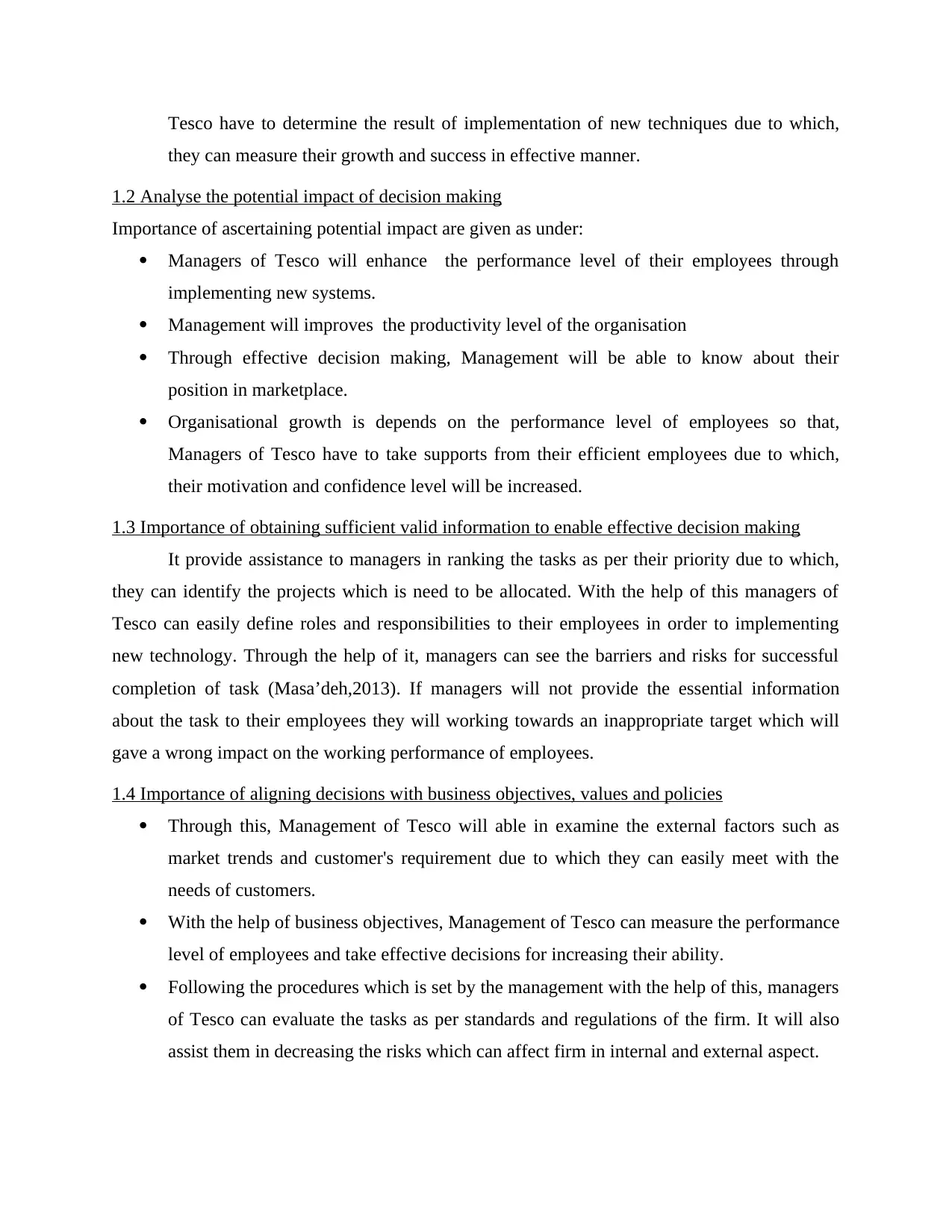
Tesco have to determine the result of implementation of new techniques due to which,
they can measure their growth and success in effective manner.
1.2 Analyse the potential impact of decision making
Importance of ascertaining potential impact are given as under:
Managers of Tesco will enhance the performance level of their employees through
implementing new systems.
Management will improves the productivity level of the organisation
Through effective decision making, Management will be able to know about their
position in marketplace.
Organisational growth is depends on the performance level of employees so that,
Managers of Tesco have to take supports from their efficient employees due to which,
their motivation and confidence level will be increased.
1.3 Importance of obtaining sufficient valid information to enable effective decision making
It provide assistance to managers in ranking the tasks as per their priority due to which,
they can identify the projects which is need to be allocated. With the help of this managers of
Tesco can easily define roles and responsibilities to their employees in order to implementing
new technology. Through the help of it, managers can see the barriers and risks for successful
completion of task (Masa’deh,2013). If managers will not provide the essential information
about the task to their employees they will working towards an inappropriate target which will
gave a wrong impact on the working performance of employees.
1.4 Importance of aligning decisions with business objectives, values and policies
Through this, Management of Tesco will able in examine the external factors such as
market trends and customer's requirement due to which they can easily meet with the
needs of customers.
With the help of business objectives, Management of Tesco can measure the performance
level of employees and take effective decisions for increasing their ability.
Following the procedures which is set by the management with the help of this, managers
of Tesco can evaluate the tasks as per standards and regulations of the firm. It will also
assist them in decreasing the risks which can affect firm in internal and external aspect.
they can measure their growth and success in effective manner.
1.2 Analyse the potential impact of decision making
Importance of ascertaining potential impact are given as under:
Managers of Tesco will enhance the performance level of their employees through
implementing new systems.
Management will improves the productivity level of the organisation
Through effective decision making, Management will be able to know about their
position in marketplace.
Organisational growth is depends on the performance level of employees so that,
Managers of Tesco have to take supports from their efficient employees due to which,
their motivation and confidence level will be increased.
1.3 Importance of obtaining sufficient valid information to enable effective decision making
It provide assistance to managers in ranking the tasks as per their priority due to which,
they can identify the projects which is need to be allocated. With the help of this managers of
Tesco can easily define roles and responsibilities to their employees in order to implementing
new technology. Through the help of it, managers can see the barriers and risks for successful
completion of task (Masa’deh,2013). If managers will not provide the essential information
about the task to their employees they will working towards an inappropriate target which will
gave a wrong impact on the working performance of employees.
1.4 Importance of aligning decisions with business objectives, values and policies
Through this, Management of Tesco will able in examine the external factors such as
market trends and customer's requirement due to which they can easily meet with the
needs of customers.
With the help of business objectives, Management of Tesco can measure the performance
level of employees and take effective decisions for increasing their ability.
Following the procedures which is set by the management with the help of this, managers
of Tesco can evaluate the tasks as per standards and regulations of the firm. It will also
assist them in decreasing the risks which can affect firm in internal and external aspect.
Secure Best Marks with AI Grader
Need help grading? Try our AI Grader for instant feedback on your assignments.
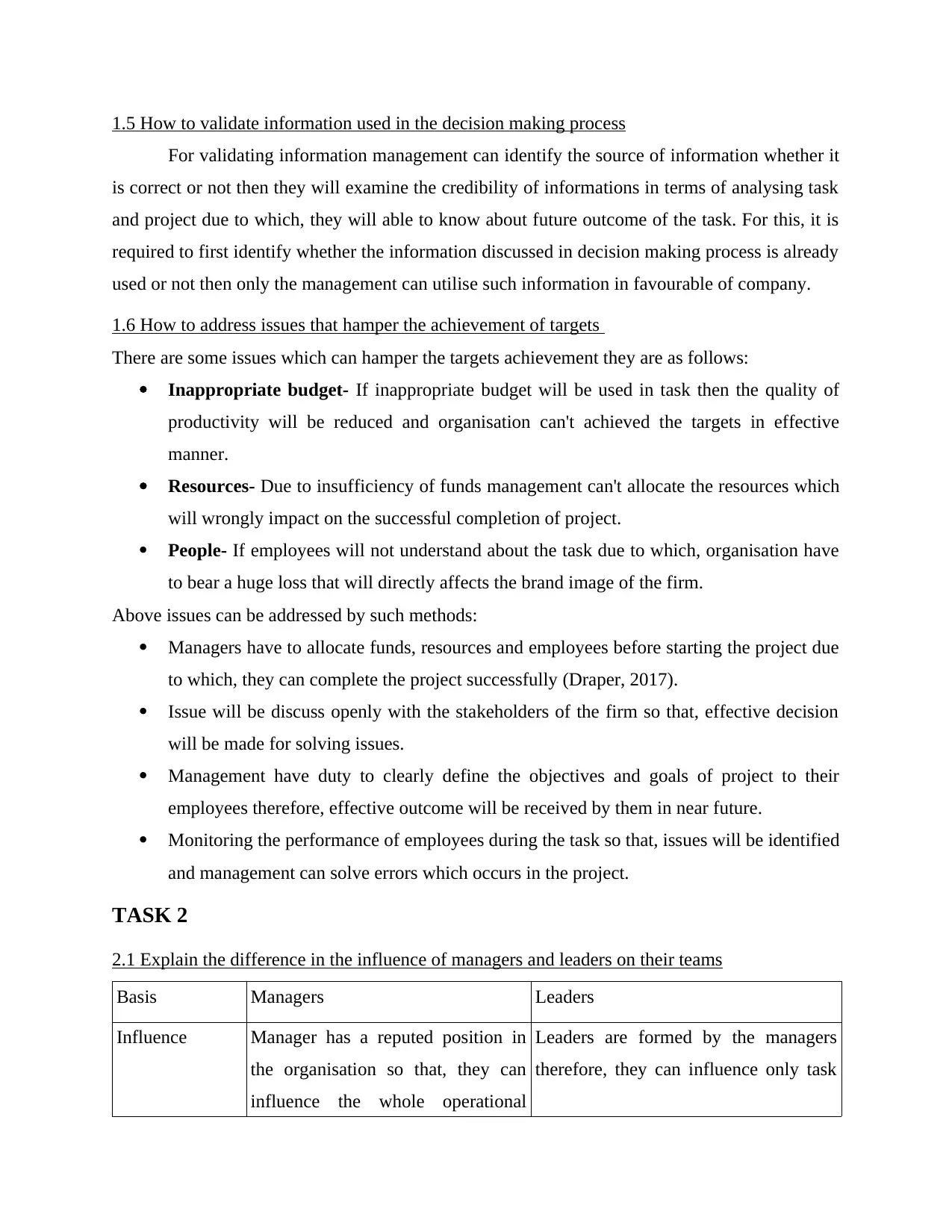
1.5 How to validate information used in the decision making process
For validating information management can identify the source of information whether it
is correct or not then they will examine the credibility of informations in terms of analysing task
and project due to which, they will able to know about future outcome of the task. For this, it is
required to first identify whether the information discussed in decision making process is already
used or not then only the management can utilise such information in favourable of company.
1.6 How to address issues that hamper the achievement of targets
There are some issues which can hamper the targets achievement they are as follows:
Inappropriate budget- If inappropriate budget will be used in task then the quality of
productivity will be reduced and organisation can't achieved the targets in effective
manner.
Resources- Due to insufficiency of funds management can't allocate the resources which
will wrongly impact on the successful completion of project.
People- If employees will not understand about the task due to which, organisation have
to bear a huge loss that will directly affects the brand image of the firm.
Above issues can be addressed by such methods:
Managers have to allocate funds, resources and employees before starting the project due
to which, they can complete the project successfully (Draper, 2017).
Issue will be discuss openly with the stakeholders of the firm so that, effective decision
will be made for solving issues.
Management have duty to clearly define the objectives and goals of project to their
employees therefore, effective outcome will be received by them in near future.
Monitoring the performance of employees during the task so that, issues will be identified
and management can solve errors which occurs in the project.
TASK 2
2.1 Explain the difference in the influence of managers and leaders on their teams
Basis Managers Leaders
Influence Manager has a reputed position in
the organisation so that, they can
influence the whole operational
Leaders are formed by the managers
therefore, they can influence only task
For validating information management can identify the source of information whether it
is correct or not then they will examine the credibility of informations in terms of analysing task
and project due to which, they will able to know about future outcome of the task. For this, it is
required to first identify whether the information discussed in decision making process is already
used or not then only the management can utilise such information in favourable of company.
1.6 How to address issues that hamper the achievement of targets
There are some issues which can hamper the targets achievement they are as follows:
Inappropriate budget- If inappropriate budget will be used in task then the quality of
productivity will be reduced and organisation can't achieved the targets in effective
manner.
Resources- Due to insufficiency of funds management can't allocate the resources which
will wrongly impact on the successful completion of project.
People- If employees will not understand about the task due to which, organisation have
to bear a huge loss that will directly affects the brand image of the firm.
Above issues can be addressed by such methods:
Managers have to allocate funds, resources and employees before starting the project due
to which, they can complete the project successfully (Draper, 2017).
Issue will be discuss openly with the stakeholders of the firm so that, effective decision
will be made for solving issues.
Management have duty to clearly define the objectives and goals of project to their
employees therefore, effective outcome will be received by them in near future.
Monitoring the performance of employees during the task so that, issues will be identified
and management can solve errors which occurs in the project.
TASK 2
2.1 Explain the difference in the influence of managers and leaders on their teams
Basis Managers Leaders
Influence Manager has a reputed position in
the organisation so that, they can
influence the whole operational
Leaders are formed by the managers
therefore, they can influence only task
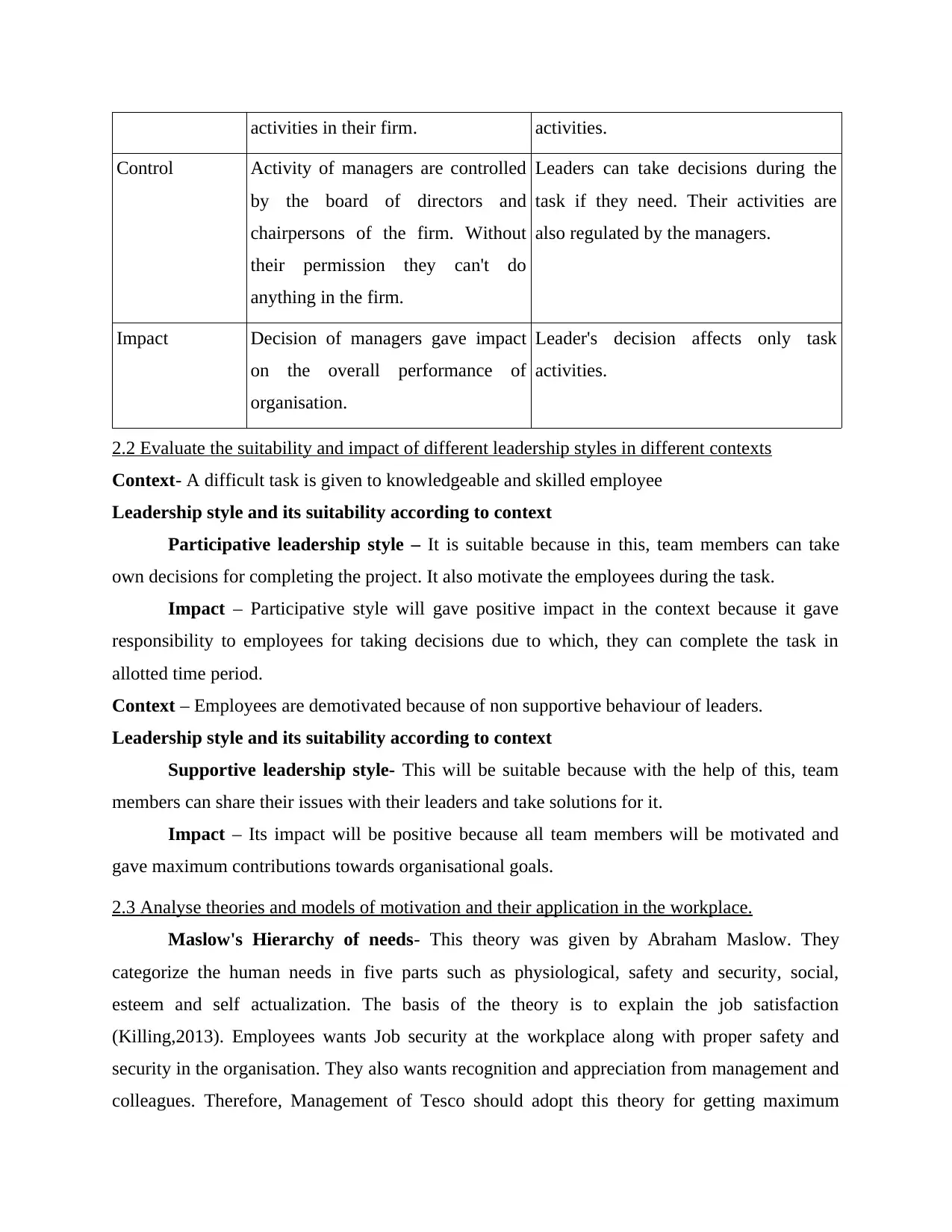
activities in their firm. activities.
Control Activity of managers are controlled
by the board of directors and
chairpersons of the firm. Without
their permission they can't do
anything in the firm.
Leaders can take decisions during the
task if they need. Their activities are
also regulated by the managers.
Impact Decision of managers gave impact
on the overall performance of
organisation.
Leader's decision affects only task
activities.
2.2 Evaluate the suitability and impact of different leadership styles in different contexts
Context- A difficult task is given to knowledgeable and skilled employee
Leadership style and its suitability according to context
Participative leadership style – It is suitable because in this, team members can take
own decisions for completing the project. It also motivate the employees during the task.
Impact – Participative style will gave positive impact in the context because it gave
responsibility to employees for taking decisions due to which, they can complete the task in
allotted time period.
Context – Employees are demotivated because of non supportive behaviour of leaders.
Leadership style and its suitability according to context
Supportive leadership style- This will be suitable because with the help of this, team
members can share their issues with their leaders and take solutions for it.
Impact – Its impact will be positive because all team members will be motivated and
gave maximum contributions towards organisational goals.
2.3 Analyse theories and models of motivation and their application in the workplace.
Maslow's Hierarchy of needs- This theory was given by Abraham Maslow. They
categorize the human needs in five parts such as physiological, safety and security, social,
esteem and self actualization. The basis of the theory is to explain the job satisfaction
(Killing,2013). Employees wants Job security at the workplace along with proper safety and
security in the organisation. They also wants recognition and appreciation from management and
colleagues. Therefore, Management of Tesco should adopt this theory for getting maximum
Control Activity of managers are controlled
by the board of directors and
chairpersons of the firm. Without
their permission they can't do
anything in the firm.
Leaders can take decisions during the
task if they need. Their activities are
also regulated by the managers.
Impact Decision of managers gave impact
on the overall performance of
organisation.
Leader's decision affects only task
activities.
2.2 Evaluate the suitability and impact of different leadership styles in different contexts
Context- A difficult task is given to knowledgeable and skilled employee
Leadership style and its suitability according to context
Participative leadership style – It is suitable because in this, team members can take
own decisions for completing the project. It also motivate the employees during the task.
Impact – Participative style will gave positive impact in the context because it gave
responsibility to employees for taking decisions due to which, they can complete the task in
allotted time period.
Context – Employees are demotivated because of non supportive behaviour of leaders.
Leadership style and its suitability according to context
Supportive leadership style- This will be suitable because with the help of this, team
members can share their issues with their leaders and take solutions for it.
Impact – Its impact will be positive because all team members will be motivated and
gave maximum contributions towards organisational goals.
2.3 Analyse theories and models of motivation and their application in the workplace.
Maslow's Hierarchy of needs- This theory was given by Abraham Maslow. They
categorize the human needs in five parts such as physiological, safety and security, social,
esteem and self actualization. The basis of the theory is to explain the job satisfaction
(Killing,2013). Employees wants Job security at the workplace along with proper safety and
security in the organisation. They also wants recognition and appreciation from management and
colleagues. Therefore, Management of Tesco should adopt this theory for getting maximum
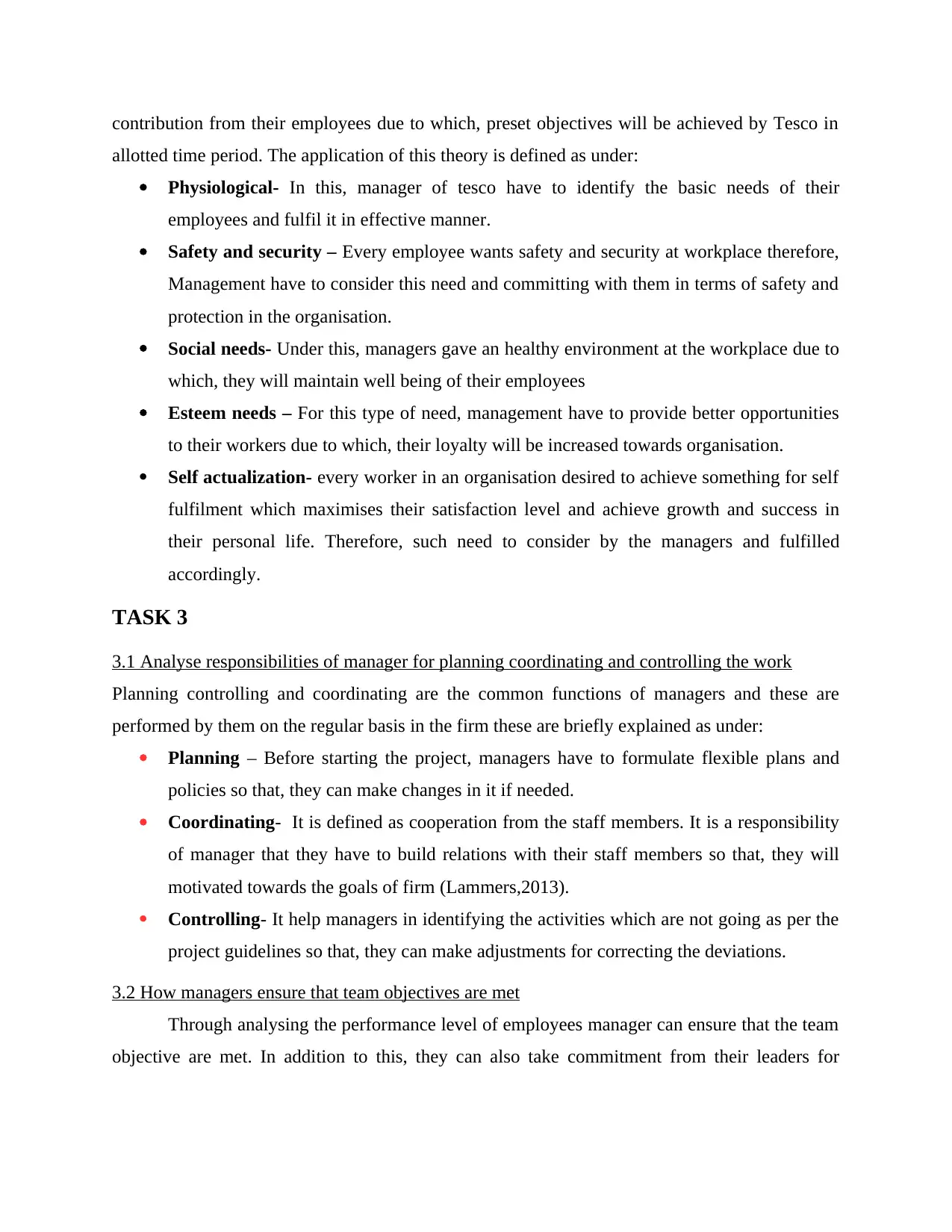
contribution from their employees due to which, preset objectives will be achieved by Tesco in
allotted time period. The application of this theory is defined as under:
Physiological- In this, manager of tesco have to identify the basic needs of their
employees and fulfil it in effective manner.
Safety and security – Every employee wants safety and security at workplace therefore,
Management have to consider this need and committing with them in terms of safety and
protection in the organisation.
Social needs- Under this, managers gave an healthy environment at the workplace due to
which, they will maintain well being of their employees
Esteem needs – For this type of need, management have to provide better opportunities
to their workers due to which, their loyalty will be increased towards organisation.
Self actualization- every worker in an organisation desired to achieve something for self
fulfilment which maximises their satisfaction level and achieve growth and success in
their personal life. Therefore, such need to consider by the managers and fulfilled
accordingly.
TASK 3
3.1 Analyse responsibilities of manager for planning coordinating and controlling the work
Planning controlling and coordinating are the common functions of managers and these are
performed by them on the regular basis in the firm these are briefly explained as under:
Planning – Before starting the project, managers have to formulate flexible plans and
policies so that, they can make changes in it if needed.
Coordinating- It is defined as cooperation from the staff members. It is a responsibility
of manager that they have to build relations with their staff members so that, they will
motivated towards the goals of firm (Lammers,2013).
Controlling- It help managers in identifying the activities which are not going as per the
project guidelines so that, they can make adjustments for correcting the deviations.
3.2 How managers ensure that team objectives are met
Through analysing the performance level of employees manager can ensure that the team
objective are met. In addition to this, they can also take commitment from their leaders for
allotted time period. The application of this theory is defined as under:
Physiological- In this, manager of tesco have to identify the basic needs of their
employees and fulfil it in effective manner.
Safety and security – Every employee wants safety and security at workplace therefore,
Management have to consider this need and committing with them in terms of safety and
protection in the organisation.
Social needs- Under this, managers gave an healthy environment at the workplace due to
which, they will maintain well being of their employees
Esteem needs – For this type of need, management have to provide better opportunities
to their workers due to which, their loyalty will be increased towards organisation.
Self actualization- every worker in an organisation desired to achieve something for self
fulfilment which maximises their satisfaction level and achieve growth and success in
their personal life. Therefore, such need to consider by the managers and fulfilled
accordingly.
TASK 3
3.1 Analyse responsibilities of manager for planning coordinating and controlling the work
Planning controlling and coordinating are the common functions of managers and these are
performed by them on the regular basis in the firm these are briefly explained as under:
Planning – Before starting the project, managers have to formulate flexible plans and
policies so that, they can make changes in it if needed.
Coordinating- It is defined as cooperation from the staff members. It is a responsibility
of manager that they have to build relations with their staff members so that, they will
motivated towards the goals of firm (Lammers,2013).
Controlling- It help managers in identifying the activities which are not going as per the
project guidelines so that, they can make adjustments for correcting the deviations.
3.2 How managers ensure that team objectives are met
Through analysing the performance level of employees manager can ensure that the team
objective are met. In addition to this, they can also take commitment from their leaders for
Paraphrase This Document
Need a fresh take? Get an instant paraphrase of this document with our AI Paraphraser
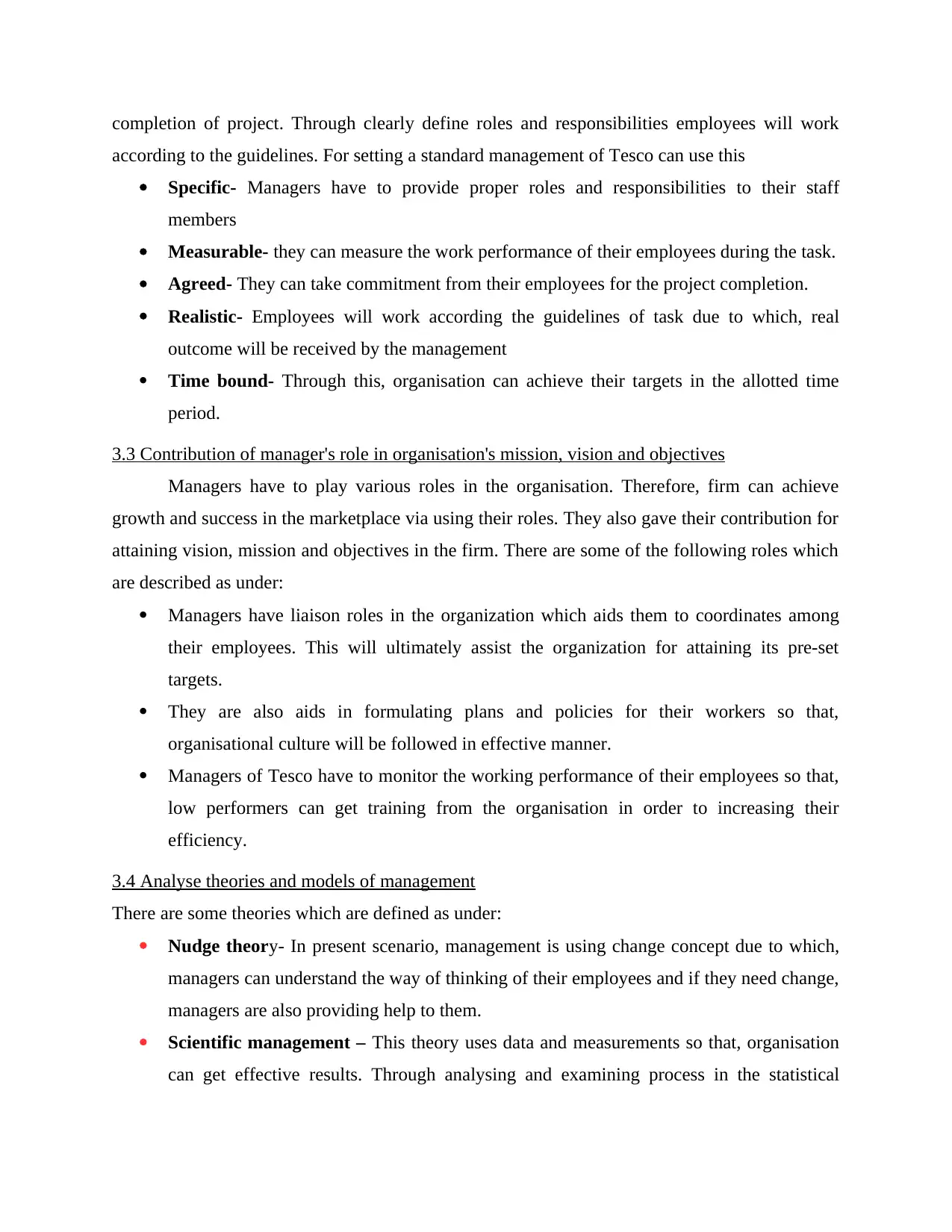
completion of project. Through clearly define roles and responsibilities employees will work
according to the guidelines. For setting a standard management of Tesco can use this
Specific- Managers have to provide proper roles and responsibilities to their staff
members
Measurable- they can measure the work performance of their employees during the task.
Agreed- They can take commitment from their employees for the project completion.
Realistic- Employees will work according the guidelines of task due to which, real
outcome will be received by the management
Time bound- Through this, organisation can achieve their targets in the allotted time
period.
3.3 Contribution of manager's role in organisation's mission, vision and objectives
Managers have to play various roles in the organisation. Therefore, firm can achieve
growth and success in the marketplace via using their roles. They also gave their contribution for
attaining vision, mission and objectives in the firm. There are some of the following roles which
are described as under:
Managers have liaison roles in the organization which aids them to coordinates among
their employees. This will ultimately assist the organization for attaining its pre-set
targets.
They are also aids in formulating plans and policies for their workers so that,
organisational culture will be followed in effective manner.
Managers of Tesco have to monitor the working performance of their employees so that,
low performers can get training from the organisation in order to increasing their
efficiency.
3.4 Analyse theories and models of management
There are some theories which are defined as under:
Nudge theory- In present scenario, management is using change concept due to which,
managers can understand the way of thinking of their employees and if they need change,
managers are also providing help to them.
Scientific management – This theory uses data and measurements so that, organisation
can get effective results. Through analysing and examining process in the statistical
according to the guidelines. For setting a standard management of Tesco can use this
Specific- Managers have to provide proper roles and responsibilities to their staff
members
Measurable- they can measure the work performance of their employees during the task.
Agreed- They can take commitment from their employees for the project completion.
Realistic- Employees will work according the guidelines of task due to which, real
outcome will be received by the management
Time bound- Through this, organisation can achieve their targets in the allotted time
period.
3.3 Contribution of manager's role in organisation's mission, vision and objectives
Managers have to play various roles in the organisation. Therefore, firm can achieve
growth and success in the marketplace via using their roles. They also gave their contribution for
attaining vision, mission and objectives in the firm. There are some of the following roles which
are described as under:
Managers have liaison roles in the organization which aids them to coordinates among
their employees. This will ultimately assist the organization for attaining its pre-set
targets.
They are also aids in formulating plans and policies for their workers so that,
organisational culture will be followed in effective manner.
Managers of Tesco have to monitor the working performance of their employees so that,
low performers can get training from the organisation in order to increasing their
efficiency.
3.4 Analyse theories and models of management
There are some theories which are defined as under:
Nudge theory- In present scenario, management is using change concept due to which,
managers can understand the way of thinking of their employees and if they need change,
managers are also providing help to them.
Scientific management – This theory uses data and measurements so that, organisation
can get effective results. Through analysing and examining process in the statistical
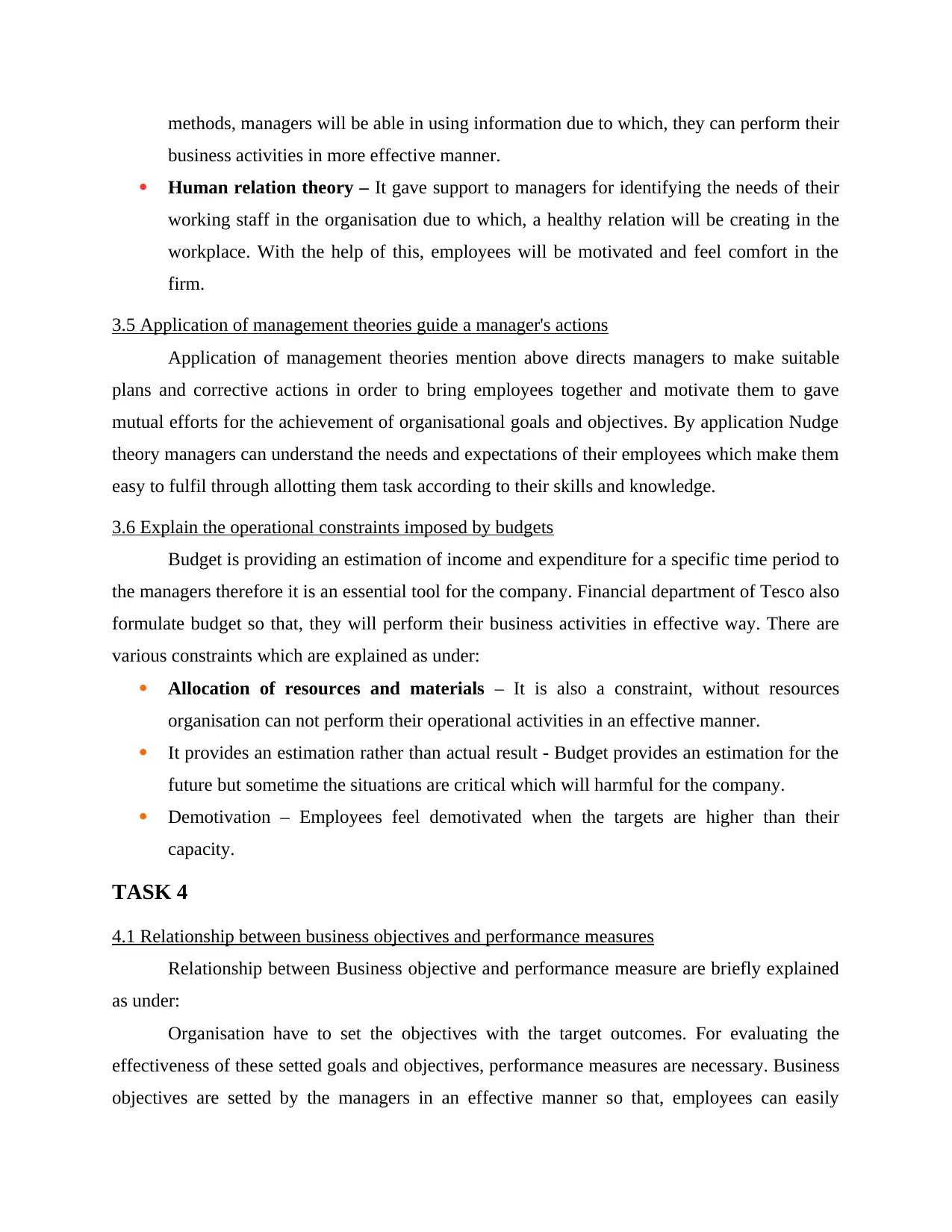
methods, managers will be able in using information due to which, they can perform their
business activities in more effective manner.
Human relation theory – It gave support to managers for identifying the needs of their
working staff in the organisation due to which, a healthy relation will be creating in the
workplace. With the help of this, employees will be motivated and feel comfort in the
firm.
3.5 Application of management theories guide a manager's actions
Application of management theories mention above directs managers to make suitable
plans and corrective actions in order to bring employees together and motivate them to gave
mutual efforts for the achievement of organisational goals and objectives. By application Nudge
theory managers can understand the needs and expectations of their employees which make them
easy to fulfil through allotting them task according to their skills and knowledge.
3.6 Explain the operational constraints imposed by budgets
Budget is providing an estimation of income and expenditure for a specific time period to
the managers therefore it is an essential tool for the company. Financial department of Tesco also
formulate budget so that, they will perform their business activities in effective way. There are
various constraints which are explained as under:
Allocation of resources and materials – It is also a constraint, without resources
organisation can not perform their operational activities in an effective manner.
It provides an estimation rather than actual result - Budget provides an estimation for the
future but sometime the situations are critical which will harmful for the company.
Demotivation – Employees feel demotivated when the targets are higher than their
capacity.
TASK 4
4.1 Relationship between business objectives and performance measures
Relationship between Business objective and performance measure are briefly explained
as under:
Organisation have to set the objectives with the target outcomes. For evaluating the
effectiveness of these setted goals and objectives, performance measures are necessary. Business
objectives are setted by the managers in an effective manner so that, employees can easily
business activities in more effective manner.
Human relation theory – It gave support to managers for identifying the needs of their
working staff in the organisation due to which, a healthy relation will be creating in the
workplace. With the help of this, employees will be motivated and feel comfort in the
firm.
3.5 Application of management theories guide a manager's actions
Application of management theories mention above directs managers to make suitable
plans and corrective actions in order to bring employees together and motivate them to gave
mutual efforts for the achievement of organisational goals and objectives. By application Nudge
theory managers can understand the needs and expectations of their employees which make them
easy to fulfil through allotting them task according to their skills and knowledge.
3.6 Explain the operational constraints imposed by budgets
Budget is providing an estimation of income and expenditure for a specific time period to
the managers therefore it is an essential tool for the company. Financial department of Tesco also
formulate budget so that, they will perform their business activities in effective way. There are
various constraints which are explained as under:
Allocation of resources and materials – It is also a constraint, without resources
organisation can not perform their operational activities in an effective manner.
It provides an estimation rather than actual result - Budget provides an estimation for the
future but sometime the situations are critical which will harmful for the company.
Demotivation – Employees feel demotivated when the targets are higher than their
capacity.
TASK 4
4.1 Relationship between business objectives and performance measures
Relationship between Business objective and performance measure are briefly explained
as under:
Organisation have to set the objectives with the target outcomes. For evaluating the
effectiveness of these setted goals and objectives, performance measures are necessary. Business
objectives are setted by the managers in an effective manner so that, employees can easily

achieve their objectives in an appropriate manner. It is important for the management to analyse
the performance of their employees due to which, they will provide the training to the low
performers of their firm through which, the capabilities of employees will be increased and they
will provide more contribution in achieving the organisational objectives.
Therefore, it can be said that there is an interrelation between organisational objectives
and performance level of employees.
4.2 Features of a performance measure system
The main features of performance measure system are they are reliable and good. It can
be used by the management in measuring the performance level of employees. There are various
features of this system which are defined as under:
Performance of this system can be measured and evaluated by the management
It creates interrelation between the management and staff members.
It gave actual results about working performance of employees.
Therefore, it can be said that these system are useful for the firm because with the help of this,
managers are able in knowing the skills and strength of working staff.
4.3 How to set the key performance indicators
There are some steps which can used in setting KPI they are as follows:
Establish goals and objectives – In this part, Management have to set their plans and
objectives so that, employees will working according to the task
Establish critical success factors- In this part, management can evaluate the
performance level of their employees due to which, they can identify the lower or higher
performer.
Establish key performance indicator- Management can set the standard of performance
so that, employees will be gave maximum efforts in their assigned task.
Collect measures – Under this, managers can measure the actual performance in order to
identify the deviations
Calculate metrics from measures – In this part, management can resolve identified
deviation through adopting corrective actions (Scheer,2012).
the performance of their employees due to which, they will provide the training to the low
performers of their firm through which, the capabilities of employees will be increased and they
will provide more contribution in achieving the organisational objectives.
Therefore, it can be said that there is an interrelation between organisational objectives
and performance level of employees.
4.2 Features of a performance measure system
The main features of performance measure system are they are reliable and good. It can
be used by the management in measuring the performance level of employees. There are various
features of this system which are defined as under:
Performance of this system can be measured and evaluated by the management
It creates interrelation between the management and staff members.
It gave actual results about working performance of employees.
Therefore, it can be said that these system are useful for the firm because with the help of this,
managers are able in knowing the skills and strength of working staff.
4.3 How to set the key performance indicators
There are some steps which can used in setting KPI they are as follows:
Establish goals and objectives – In this part, Management have to set their plans and
objectives so that, employees will working according to the task
Establish critical success factors- In this part, management can evaluate the
performance level of their employees due to which, they can identify the lower or higher
performer.
Establish key performance indicator- Management can set the standard of performance
so that, employees will be gave maximum efforts in their assigned task.
Collect measures – Under this, managers can measure the actual performance in order to
identify the deviations
Calculate metrics from measures – In this part, management can resolve identified
deviation through adopting corrective actions (Scheer,2012).
Secure Best Marks with AI Grader
Need help grading? Try our AI Grader for instant feedback on your assignments.
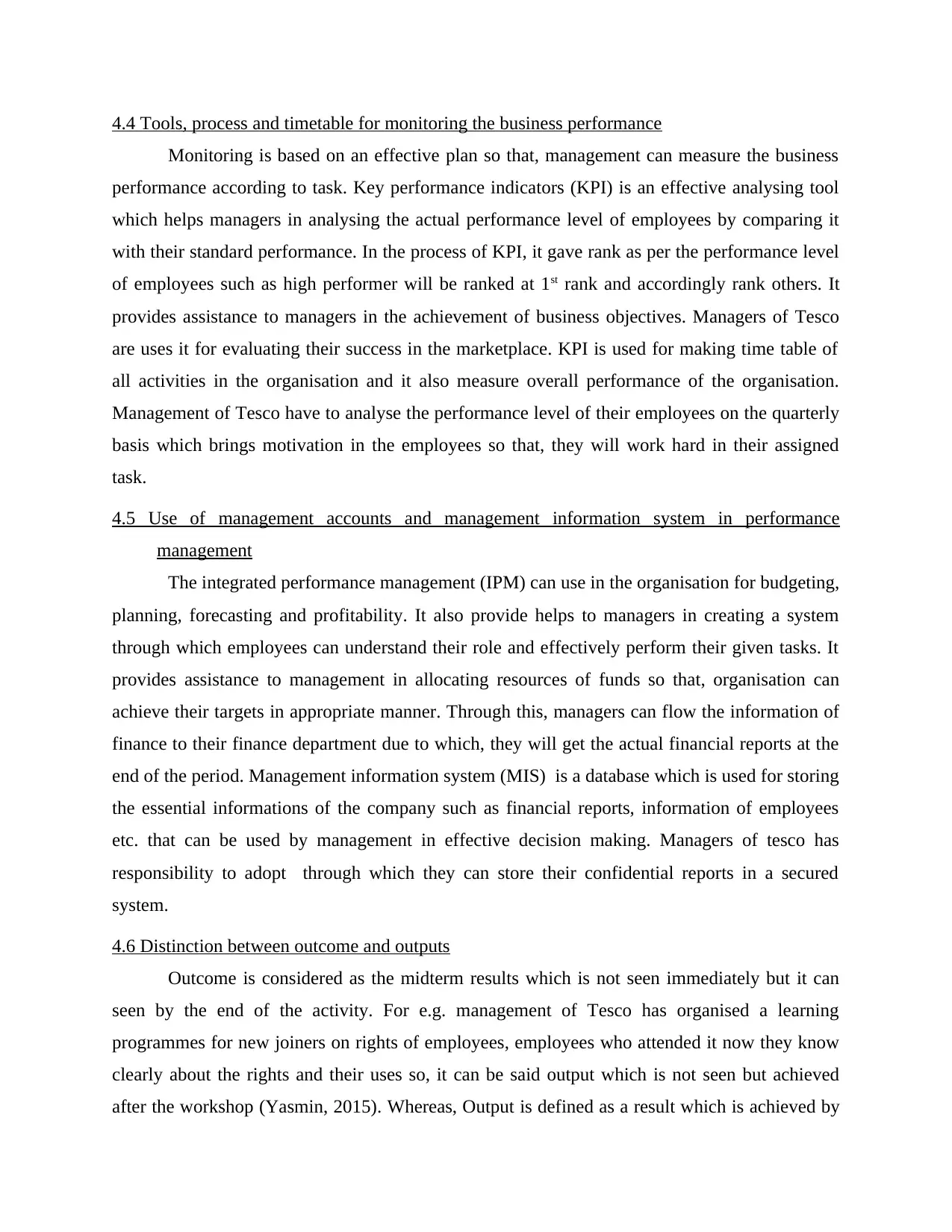
4.4 Tools, process and timetable for monitoring the business performance
Monitoring is based on an effective plan so that, management can measure the business
performance according to task. Key performance indicators (KPI) is an effective analysing tool
which helps managers in analysing the actual performance level of employees by comparing it
with their standard performance. In the process of KPI, it gave rank as per the performance level
of employees such as high performer will be ranked at 1st rank and accordingly rank others. It
provides assistance to managers in the achievement of business objectives. Managers of Tesco
are uses it for evaluating their success in the marketplace. KPI is used for making time table of
all activities in the organisation and it also measure overall performance of the organisation.
Management of Tesco have to analyse the performance level of their employees on the quarterly
basis which brings motivation in the employees so that, they will work hard in their assigned
task.
4.5 Use of management accounts and management information system in performance
management
The integrated performance management (IPM) can use in the organisation for budgeting,
planning, forecasting and profitability. It also provide helps to managers in creating a system
through which employees can understand their role and effectively perform their given tasks. It
provides assistance to management in allocating resources of funds so that, organisation can
achieve their targets in appropriate manner. Through this, managers can flow the information of
finance to their finance department due to which, they will get the actual financial reports at the
end of the period. Management information system (MIS) is a database which is used for storing
the essential informations of the company such as financial reports, information of employees
etc. that can be used by management in effective decision making. Managers of tesco has
responsibility to adopt through which they can store their confidential reports in a secured
system.
4.6 Distinction between outcome and outputs
Outcome is considered as the midterm results which is not seen immediately but it can
seen by the end of the activity. For e.g. management of Tesco has organised a learning
programmes for new joiners on rights of employees, employees who attended it now they know
clearly about the rights and their uses so, it can be said output which is not seen but achieved
after the workshop (Yasmin, 2015). Whereas, Output is defined as a result which is achieved by
Monitoring is based on an effective plan so that, management can measure the business
performance according to task. Key performance indicators (KPI) is an effective analysing tool
which helps managers in analysing the actual performance level of employees by comparing it
with their standard performance. In the process of KPI, it gave rank as per the performance level
of employees such as high performer will be ranked at 1st rank and accordingly rank others. It
provides assistance to managers in the achievement of business objectives. Managers of Tesco
are uses it for evaluating their success in the marketplace. KPI is used for making time table of
all activities in the organisation and it also measure overall performance of the organisation.
Management of Tesco have to analyse the performance level of their employees on the quarterly
basis which brings motivation in the employees so that, they will work hard in their assigned
task.
4.5 Use of management accounts and management information system in performance
management
The integrated performance management (IPM) can use in the organisation for budgeting,
planning, forecasting and profitability. It also provide helps to managers in creating a system
through which employees can understand their role and effectively perform their given tasks. It
provides assistance to management in allocating resources of funds so that, organisation can
achieve their targets in appropriate manner. Through this, managers can flow the information of
finance to their finance department due to which, they will get the actual financial reports at the
end of the period. Management information system (MIS) is a database which is used for storing
the essential informations of the company such as financial reports, information of employees
etc. that can be used by management in effective decision making. Managers of tesco has
responsibility to adopt through which they can store their confidential reports in a secured
system.
4.6 Distinction between outcome and outputs
Outcome is considered as the midterm results which is not seen immediately but it can
seen by the end of the activity. For e.g. management of Tesco has organised a learning
programmes for new joiners on rights of employees, employees who attended it now they know
clearly about the rights and their uses so, it can be said output which is not seen but achieved
after the workshop (Yasmin, 2015). Whereas, Output is defined as a result which is achieved by
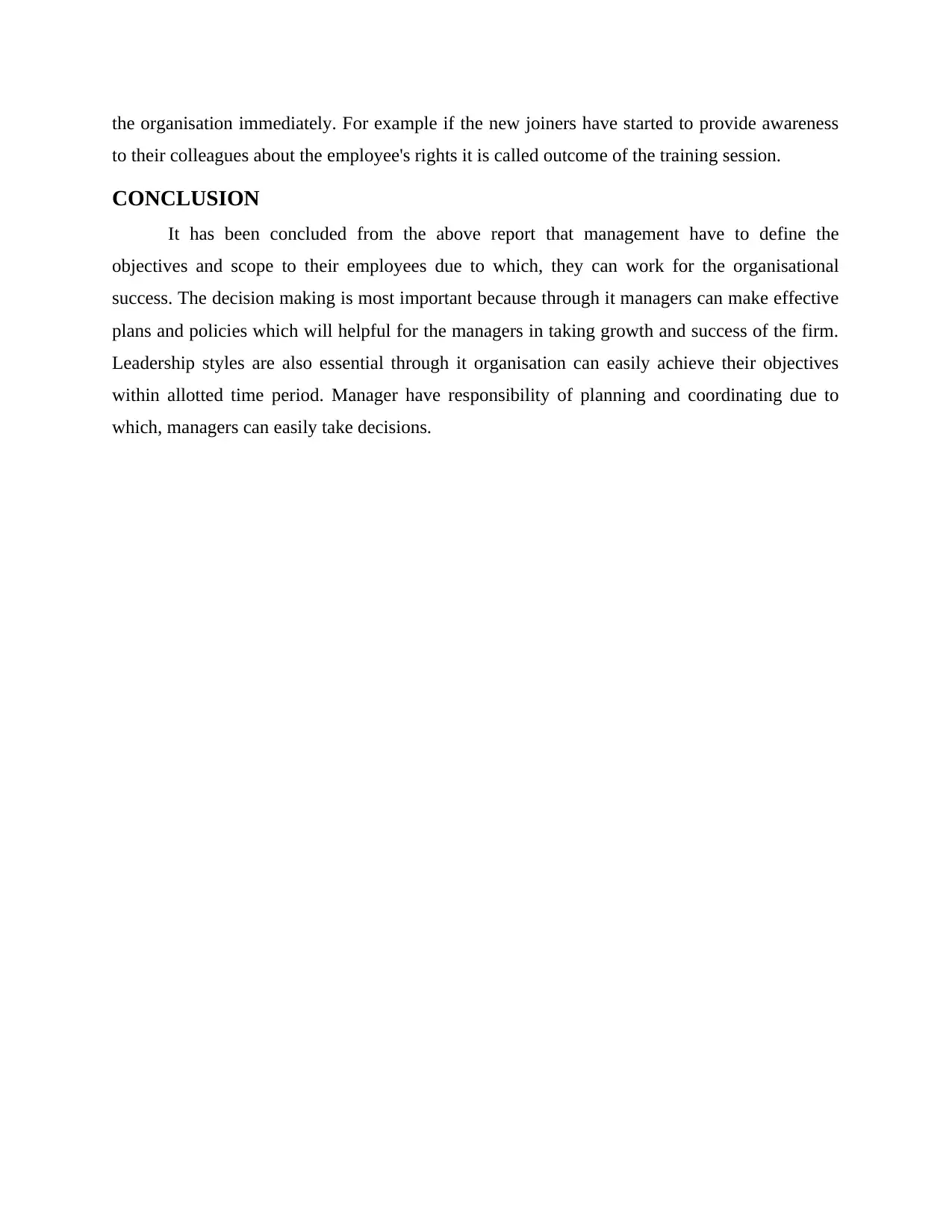
the organisation immediately. For example if the new joiners have started to provide awareness
to their colleagues about the employee's rights it is called outcome of the training session.
CONCLUSION
It has been concluded from the above report that management have to define the
objectives and scope to their employees due to which, they can work for the organisational
success. The decision making is most important because through it managers can make effective
plans and policies which will helpful for the managers in taking growth and success of the firm.
Leadership styles are also essential through it organisation can easily achieve their objectives
within allotted time period. Manager have responsibility of planning and coordinating due to
which, managers can easily take decisions.
to their colleagues about the employee's rights it is called outcome of the training session.
CONCLUSION
It has been concluded from the above report that management have to define the
objectives and scope to their employees due to which, they can work for the organisational
success. The decision making is most important because through it managers can make effective
plans and policies which will helpful for the managers in taking growth and success of the firm.
Leadership styles are also essential through it organisation can easily achieve their objectives
within allotted time period. Manager have responsibility of planning and coordinating due to
which, managers can easily take decisions.
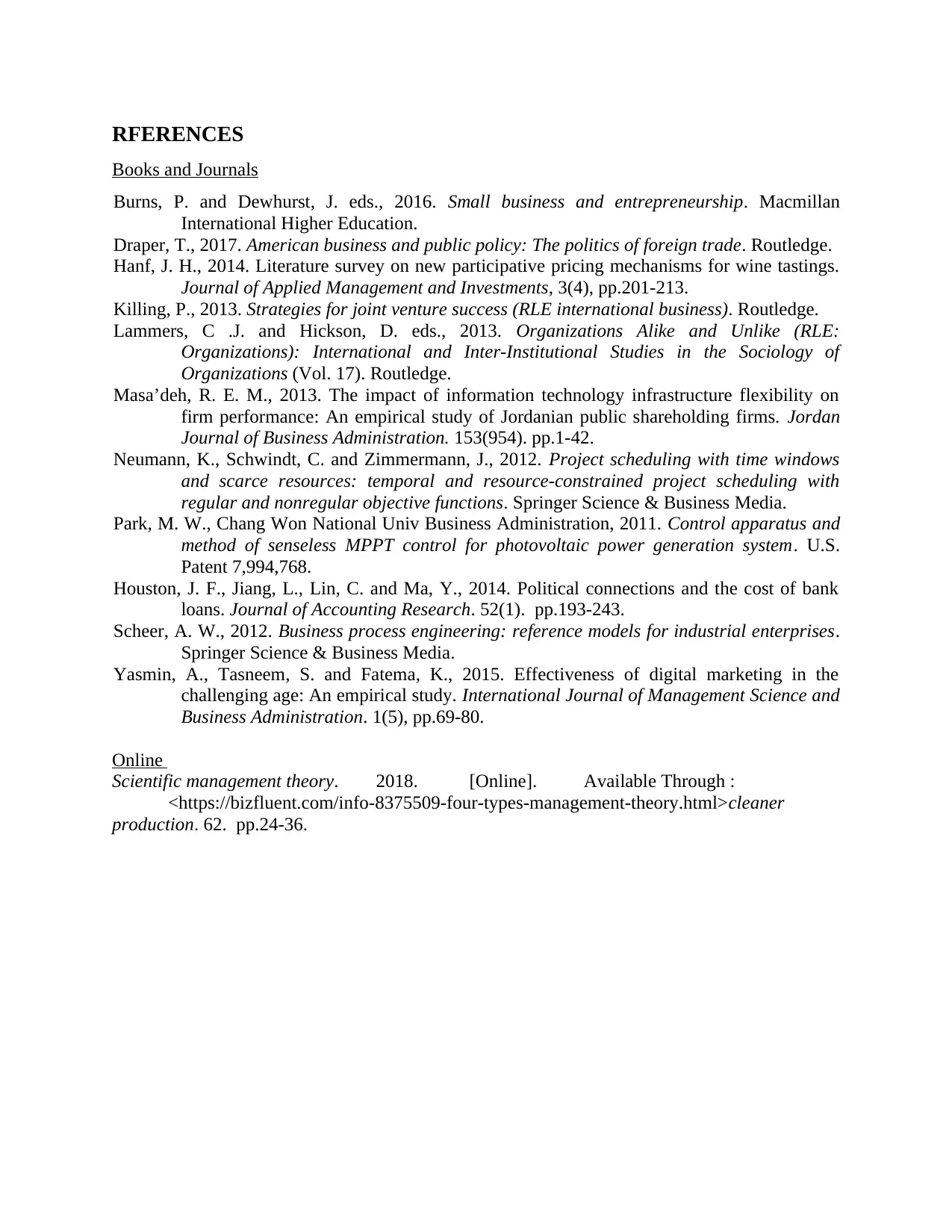
RFERENCES
Books and Journals
Burns, P. and Dewhurst, J. eds., 2016. Small business and entrepreneurship. Macmillan
International Higher Education.
Draper, T., 2017. American business and public policy: The politics of foreign trade. Routledge.
Hanf, J. H., 2014. Literature survey on new participative pricing mechanisms for wine tastings.
Journal of Applied Management and Investments, 3(4), pp.201-213.
Killing, P., 2013. Strategies for joint venture success (RLE international business). Routledge.
Lammers, C .J. and Hickson, D. eds., 2013. Organizations Alike and Unlike (RLE:
Organizations): International and Inter-Institutional Studies in the Sociology of
Organizations (Vol. 17). Routledge.
Masa’deh, R. E. M., 2013. The impact of information technology infrastructure flexibility on
firm performance: An empirical study of Jordanian public shareholding firms. Jordan
Journal of Business Administration. 153(954). pp.1-42.
Neumann, K., Schwindt, C. and Zimmermann, J., 2012. Project scheduling with time windows
and scarce resources: temporal and resource-constrained project scheduling with
regular and nonregular objective functions. Springer Science & Business Media.
Park, M. W., Chang Won National Univ Business Administration, 2011. Control apparatus and
method of senseless MPPT control for photovoltaic power generation system. U.S.
Patent 7,994,768.
Houston, J. F., Jiang, L., Lin, C. and Ma, Y., 2014. Political connections and the cost of bank
loans. Journal of Accounting Research. 52(1). pp.193-243.
Scheer, A. W., 2012. Business process engineering: reference models for industrial enterprises.
Springer Science & Business Media.
Yasmin, A., Tasneem, S. and Fatema, K., 2015. Effectiveness of digital marketing in the
challenging age: An empirical study. International Journal of Management Science and
Business Administration. 1(5), pp.69-80.
Online
Scientific management theory. 2018. [Online]. Available Through :
<https://bizfluent.com/info-8375509-four-types-management-theory.html>cleaner
production. 62. pp.24-36.
Books and Journals
Burns, P. and Dewhurst, J. eds., 2016. Small business and entrepreneurship. Macmillan
International Higher Education.
Draper, T., 2017. American business and public policy: The politics of foreign trade. Routledge.
Hanf, J. H., 2014. Literature survey on new participative pricing mechanisms for wine tastings.
Journal of Applied Management and Investments, 3(4), pp.201-213.
Killing, P., 2013. Strategies for joint venture success (RLE international business). Routledge.
Lammers, C .J. and Hickson, D. eds., 2013. Organizations Alike and Unlike (RLE:
Organizations): International and Inter-Institutional Studies in the Sociology of
Organizations (Vol. 17). Routledge.
Masa’deh, R. E. M., 2013. The impact of information technology infrastructure flexibility on
firm performance: An empirical study of Jordanian public shareholding firms. Jordan
Journal of Business Administration. 153(954). pp.1-42.
Neumann, K., Schwindt, C. and Zimmermann, J., 2012. Project scheduling with time windows
and scarce resources: temporal and resource-constrained project scheduling with
regular and nonregular objective functions. Springer Science & Business Media.
Park, M. W., Chang Won National Univ Business Administration, 2011. Control apparatus and
method of senseless MPPT control for photovoltaic power generation system. U.S.
Patent 7,994,768.
Houston, J. F., Jiang, L., Lin, C. and Ma, Y., 2014. Political connections and the cost of bank
loans. Journal of Accounting Research. 52(1). pp.193-243.
Scheer, A. W., 2012. Business process engineering: reference models for industrial enterprises.
Springer Science & Business Media.
Yasmin, A., Tasneem, S. and Fatema, K., 2015. Effectiveness of digital marketing in the
challenging age: An empirical study. International Journal of Management Science and
Business Administration. 1(5), pp.69-80.
Online
Scientific management theory. 2018. [Online]. Available Through :
<https://bizfluent.com/info-8375509-four-types-management-theory.html>cleaner
production. 62. pp.24-36.
1 out of 13
Related Documents
Your All-in-One AI-Powered Toolkit for Academic Success.
+13062052269
info@desklib.com
Available 24*7 on WhatsApp / Email
![[object Object]](/_next/static/media/star-bottom.7253800d.svg)
Unlock your academic potential
© 2024 | Zucol Services PVT LTD | All rights reserved.





